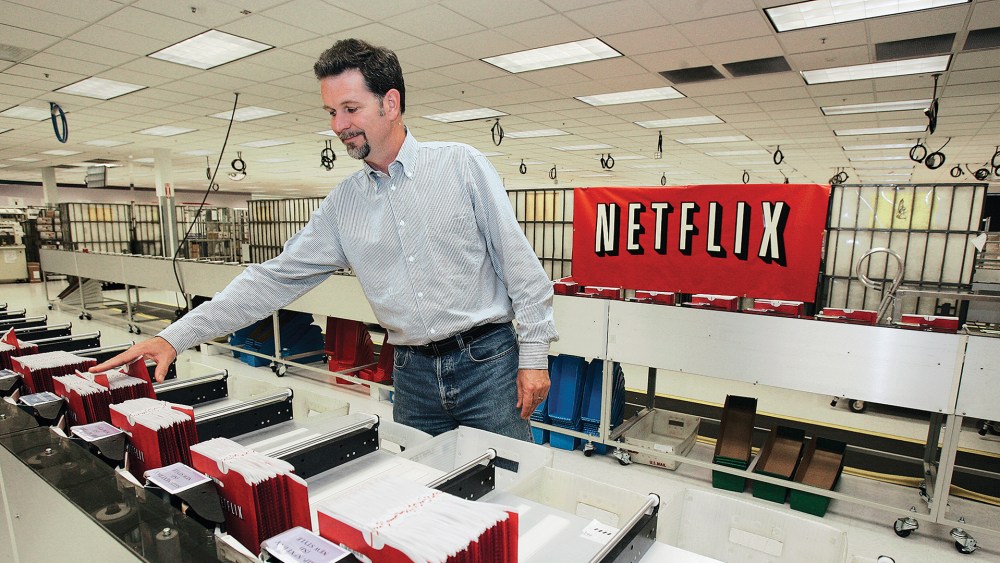No Late Fees
When Netflix began as a DVD rental service in 1998, its most compelling selling point was the elimination of late fees—a clear jab at the hated practices of Blockbuster. Although Blockbuster operated more than 9,000 stores globally, its reliance on charging substantial fines for late returns drove away many customers.
“It was an evident sore point,” said Netflix co-founder Reed Hastings. “People enjoyed renting movies, but late fees represented the most frustrating aspect of that experience. We aimed to create something different.” Netflix not only removed late fees, allowing customers to keep movies for as long as they wished, but also introduced a model of unlimited rentals for a single monthly fee and provided home delivery of DVDs, thereby sparing customers the hassle of going to physical stores. However, Hastings’ team had reservations about the sustainability of Netflix’s business model.
A Risky Gamble
Patty McCord, who joined Netflix in 1998 and later became its chief talent officer, recollects, “It was frightening. Late fees were Blockbuster’s lifeblood; while everyone despised them, they were essential for profitability. We wondered, ‘How will this work?’ Many believed abolishing late fees was madness, yet Reed was ready to take that risk.” This bold decision proved advantageous, as Netflix, now led by Hastings’ successors Ted Sarandos and Greg Peters, has grown to dominate Hollywood, boasting a market cap of $392.68 billion, eclipsing Disney, Warner Bros. Discovery, Paramount Global, and Comcast combined.
Early Days and Growth
Initially, Netflix was a modest operation. Executives would often visit local retailers like Walmart or Costco to buy DVDs at retail prices for rental services to its limited customer base. To expand, Netflix needed favorable contracts with studios. In 2000, Hastings recruited Sarandos, who had valuable industry connections, to help Netflix penetrate Hollywood. Although Sarandos initially worked from his bedroom in Los Angeles while surrounded by engineers in California, his personal relationships and approachable demeanor enabled him to secure DVDs from major studios like Warner Bros. and Sony.
From DVDs to Streaming
In its early years, Netflix faced significant hurdles, particularly in efficiently delivering DVDs. Much effort went into establishing a network of processing centers to expedite customer deliveries. “At first, we were unknown,” Sarandos recalls, “but perceptions began to shift. I remember seeing a post office box designated for Netflix envelopes, and soon I spotted Netflix DVDs in my doctor’s outgoing mail bin. We eventually became commonplace.”
Blockbuster initially dismissed Netflix as a threat, and according to popular stories, even declined a chance to acquire it in 2000. Blockbuster executives exhibited arrogance towards Netflix, minimizing its significance. However, as Netflix’s subscriber count rose steadily, it became clear that Blockbuster had underestimated the competition.
Challenges and Resilience
Netflix faced its own set of challenges, including a canceled IPO after the 9/11 attacks and the bursting dot-com bubble. The company’s focus on subscriber growth over immediate profitability raised concerns. “At the time, it wasn’t clear we would prevail,” states early investor Jay Hoag. “We were competing in a price war with Blockbuster, and our stock was volatile.” However, Hastings and Sarandos remained committed to offering a superior service.
From its beginning, Hastings envisioned Netflix evolving beyond DVDs. While internet technology was still evolving, Hastings aimed for Netflix to become a streaming leader. By 2007, as internet speeds improved, Netflix launched its streaming service, significantly boosting its subscriber numbers from 7.3 million to 18.3 million in just three years. Yet acquiring content remained challenging, as studios preferred to deal with traditional cable providers for first-run movies.
The Streaming Revolution
Netflix eventually signed a crucial deal with Starz to stream a selection of roughly 1,000 movies per year. Sarandos realized it was essential for Netflix to produce its own content to secure its future. Setting his sights on HBO as a competitor, he envisioned Netflix as a content powerhouse. As he pressed for more ambitious programming, Netflix secured “House of Cards,” committing to an unprecedented contract with David Fincher and agreeing to release the entire season at once.
The 2013 debut of “House of Cards” marked a turning point, as it showcased Netflix’s capacity to create high-quality content, drawing in new subscribers and signaling its arrival as a major player in Hollywood. Over the following decade, Netflix attracted filmmakers and creators seeking creative freedom and significant financial backing, leading to award-winning series and movies and establishing streaming as the dominant form of media consumption.
Conclusion: A New Era
As Netflix shifted its focus away from physical DVDs to streaming, the company progressively diminished its DVD service, officially sending its last red envelope in 2023. McCord reflects on the company’s journey, saying, “They had the courage to abandon the original business to nurture the new one. That’s the essence of the Netflix story—how many companies could manage to do that?”



